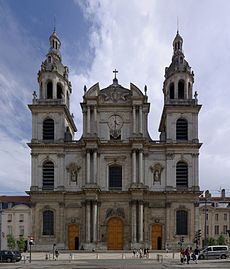Roman Catholic Diocese of Metz
The Diocese of Metz (Latin: Dioecesis Metensis ) is a location in France Roman Catholic diocese based in Metz.
History
Early and High Middle Ages
The Diocese of Metz probably founded in the 4th century and since 535 safe detectable originally belonged to the ecclesiastical province of Trier. During the Merovingian period he managed the acquisition of numerous goods, making it the remaining two bishoprics in Lorraine Toul and Verdun far exceeded - in the early Middle Ages, the Bishop possessed considerable possessions to Chiemsee to the east and the Cevennes in the south.
In the Carolingian Empire divisions after the death of Louis the Pious, the diocese came to Lorraine 843 and 870 to the eastern kingdom.
The Bishop of Metz had sovereignty over the county Metz and since 1065 also on the county Saarbrücken, but was unable to make the claim, a counterweight to the Duchy of Lorraine, do not meet. In particular, the independence of the city of Metz ( 1189 ) and the loss of the county Dagsburg reduced the influence of the Bishop considerably. Although the bishop was formally head of the city, but moved his residence to Vic- sur- seille. 1296 was the Bishop of Metz vassal of the King of France.
From the late Middle Ages to the Revolution
That since the 14th century suffering from the poor economy diocese drew increasingly the French views of Lorraine, and thus on its territories. In addition, the Popes in Avignon now always appointed clerics from southern France with relatives in Lorraine to his bishops. Although the diocese had its own territorial rule, the bishops were wont not to reside in their area.
The diocese originally counted in his spiritual administration only one archdeacon, which was supplemented by a second in the 10th century. Between 1073 and 1090 their number will be increased to 4, which then did not change much until the secularization of the diocese. These were divided since the 13th century in deaneries, parishes and harboring 1361 461 1544 540 parishes. Of these, the bishop had the right of patronage in only two parishes. In his Pontifikalfunktionen the bishop could rely on auxiliary bishops since the mid-14th century.
The cathedral chapter of St. Paul's Cathedral comprised 60 prebends, headed by the primicerius and the Dean were. Since 1224 the chapter had the right of episcopal election, but what it finally lost after the election of 1302. The Vienna Concordat, which Chapters conceded the right to vote, was expressly denied to the diocese. The bishop now chose a 1457 Cologne canons to his coadjutor, committing the chapter to choose this after his death bishop. In this way he hoped his diocese but still be able to give the free election of bishops. However, this chapter playful this opportunity and chose a candidate from Lothringen. The pope but enannte Cologne canons Hermann von Baden bishop.
From 1484 to 1607 all the bishops came from the house of Lorraine. 1552 occupied the French king, who had agreed in the Treaty of Chambord with some Protestant princes about the cities of Metz, Toul and Verdun. Charles V failed in the following year, the reconquest of Metz. The conquests were thus de facto subordinated to the French crown and removed from the Upper Rhenish Circle Empire.
Lorraine joined in 1556 all worldly rights to Metz and located in France territories to the King from. All attempts of the empire to prevent this failed on the battlefield. 1613 forced the French king to the bishop to pay homage; the powers of the governor of Metz were extended to all areas of the prince-bishopric since 1632 then, in 1648 was carried out by the Peace of Westphalia, the final assignment of the diocese of France, together with the two other high- pins Toul, and Verdun, which together formed the province of the Three Bishoprics. Formally, the bishop was now on the Lorraine parliament, but was called to 1790 still prince of the Holy Roman Empire. At this time the diocese had the feudal lords Helfedange, Habondange and Hing Sing, the gentlemen La Garde, door stone and Chatillon, the county Rixingen, the castles Remilly, Vic, Freiburg im Breisgau, baccarat and Rambervillers.
Since the 19th century
The Diocese of Metz went under in the French Revolution, was restored in 1801, the archbishopric of Besancon 1802 subordinated and 1874 - after the Franco-German War - exemt. From the German side, it was equated with the German dioceses, but always was regarded as an exceptional area. With its new case to France in 1918, it again lost the right of free election of bishops. However, it still forms together with the Archdiocese of Strasbourg an ecclesiastical territory except in France, because the two dioceses in 1905, when in France the strict separation of church and state was carried out, were not part of the French territory. So in both dioceses will be charged (as well as in the Protestant churches in Alsace and Lorraine), a church tax, in contrast to the other dioceses of the country.









